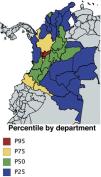Psoriasis is a chronic inflammatory disease with multiple causes and differing clinical manifestations. Plaque psoriasis is its most common cutaneous presentation. Several authors throughout the world have studied the epidemiology of psoriasis using varied methodologies, including national registry data, surveys, systematic reviews, and prospective studies,1 with prevalence values ranging from 0.09% in the Republic of Tanzania2 to 11.4% in the north of Norway.3
We performed a cross-sectional descriptive study using the databases of the Social Protection and Integrated Information System (Sistema Integral de Información de Protección Social [SISPRO]) of the Colombian Ministry of Health. Diagnoses were selected based on the International Classification of Diseases, Tenth Revision (ICD-10) codes for psoriasis vulgaris (L40.0), generalized pustular psoriasis (L40.1), acrodermatitis continua (L40.2), pustulosis palmaris et plantaris (L40.3), guttate psoriasis (L40.4), other psoriasis (L40.8), and psoriasis, unspecified (L40.9). The study was based on the population of Columbia and covered the period between January 1, 2013 and December 31, 2017.
The data include information on patients seen with diagnoses made by medical staff at hospitals and primary care centers in Colombia.4 Prevalence was calculated based on projections of population data obtained from the most recent national census (2005), which was carried out by the Colombian National Statistics Office. In 2017, the estimated population of Colombia was 49 291 609 inhabitants.5
We found a total of 34 472 confirmed cases of psoriasis in Colombia between 2013 and 2017 (prevalence, 0.069%). The clinical subtypes were distributed by decreasing prevalence as follows: psoriasis vulgaris, psoriasis, unspecified, other psoriasis, guttate psoriasis, acrodermatitis continua, psoriasis palmaris et plantaris, and generalized pustular psoriasis (Table 1).
Subtypes of Psoriasis in Colombia 2013 and 2017.
| Subtype (ICD-10 code) | No. of cases | Prevalence |
|---|---|---|
| Psoriasis vulgaris (L40.0) | 13 311 | 0.0270% |
| Psoriasis, unspecified (L40.9) | 12 271 | 0.0248% |
| Other psoriasis (L40.8) | 7361 | 0.0149% |
| Guttate psoriasis (L40.4) | 841 | 0.0017% |
| Acrodermatitis continua (L40.2) | 549 | 0.0011% |
| Psoriasis palmaris et plantaris (L40.3) | 222 | 0.0004% |
| Generalized pustular psoriasis (L40.1) | 209 | 00004% |
The ratio of men to women was 1.08:1. Men accounted for 52%, with 17 928 cases and women for 48%, with 16 544 cases. The highest prevalence of psoriasis was found for adults aged 65–69 years (197 per 100 000 persons), followed by individuals aged 70–74 years (193 per 100 000 persons) (Table 2). By administrative department, the highest prevalence values were found for Caldas (126 cases 100 000 persons), Risaralda (105 cases per 100 000 persons), and Quindío (101 cases per 100 000 persons) (Fig. 1).
Prevalence of Psoriasis by Age Group Between 2013 and 2017.
| Five-year group | Prevalence |
|---|---|
| 0–4 y | 0.005% |
| 5–9 y | 0.010% |
| 10–14 y | 0.016% |
| 15–19 y | 0.024% |
| 20–24 y | 0.032% |
| 25–29 y | 0.046% |
| 30–34 y | 0.061% |
| 35–39 y | 0.082% |
| 40–44 y | 0.096% |
| 45–49 y | 0.120% |
| 50–54 y | 0.145% |
| 55–59 y | 0.173% |
| 60–64 y | 0.183% |
| 65–69 y | 0.197% |
| 70–74 y | 0.193% |
| 75–79 y | 0.179% |
| ≥80 y | 0.172% |
The epidemiology of psoriasis has been studied throughout the world. Prevalence varies owing to differences in climate, population, and geographic location, as reported by Parisi et al.,6 who concluded that the prevalence of psoriasis is greater the farther the distance from the equator.
Epidemiological data on psoriasis are mainly from studies carried out in the United States, Europe, and the United Kingdom, with very few data available for Latin America. In addition, the multiple methodological approaches used limit the analysis of trends and comparisons with other regions.
The present study is the first to estimate the prevalence of psoriasis in Colombia, which was 0.069%, the lowest reported to date in the literature. If we compare our results with those for the rest of Latin America and the Caribbean, we find that in Brazil, a telephone questionnaire-based study carried out in 26 states and asking whether household members had been diagnosed with psoriasis revealed a prevalence of 1.31% in a total of 8947 persons surveyed.7 In Cuba, a multicenter descriptive study carried out in 7 provinces reported a prevalence of 6%,8 and in Trinidad and Tobago, studies performed in 2 hospitals between 1969 and 1973 reported a prevalence of 4%.9,10
The most frequent clinical variant of psoriasis in our study was psoriasis vulgaris (38%); the least common forms were generalized pustular psoriasis and psoriasis palmaris et plantaris (0.6% each). As for sex, the disease is almost equally represented, with a male:female ratio of 1.08:1.
Our study is limited by the possibility of error when physicians enter the ICD-10 code in the clinical history. The low number of cases of psoriasis reported is striking, even though we have fully registered information in the official databases of the Colombian National Health System, which covers 96.64% of the population according to the most recent assessment (August 2020). However, this is the data item that is legally registered in primary care and on which Colombian public health policy is based.
Conflicts of InterestThe authors declare that they have no conflicts of interest.








